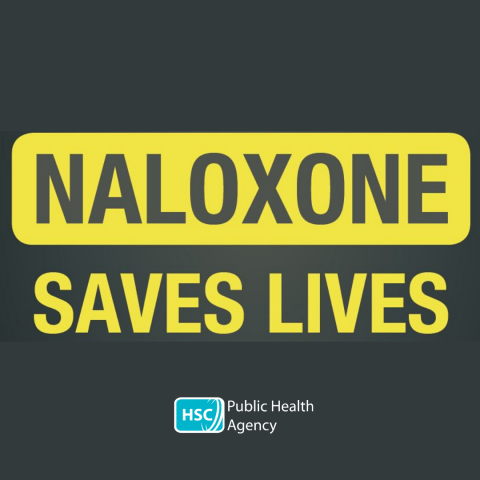Take Home Naloxone reverses more than 160 overdoses

New figures from the Public Health Agency (PHA) show that the Take Home Naloxone programme saw naloxone administered 180 times in 2019-20 and was successful in reversing an opiate overdose in over 91% of cases.
Naloxone, supplied in a small syringe, is injected intramuscularly and can be administered by anyone in an emergency overdose situation.
Since April 2014, Take Home Naloxone has been successful in reversing 598 opiate overdoses. In 2019-20, it reversed 163 overdoses.
The Public Health Agency, with support from the Health and Social Care Board, coordinates the Take Home Naloxone programme.
Michael Owen, the PHA’s Lead for Drugs and Alcohol, said: “As the figures show, this service provides an important life-saving intervention – each overdose reversal is an occasion when a person could have died, but didn’t.
“While only a very small portion of the population here uses heroin or other opiate type drugs, those who do are at a high risk of illness or death.
“It is therefore important that we look at ways that we can reduce the danger that these people face. The main risks for people who use opiates are accidental overdose, and the transmission of blood-borne viruses through sharing of injecting equipment.
“We need to ensure we do all we can to reduce these dangers, by ensuring access to needle exchange services with trained staff, and providing access to the life-saving drug naloxone.
“Addressing these risks also provides opportunities for health service engagement with this hard-to-reach group, which can be used to support them into treatment.”
Naloxone is an opioid antagonist, which temporarily and rapidly reverses the effects of heroin and other opioids. Following overdose by heroin injection, death typically occurs within one to three hours, limiting the window of opportunity to intervene.
Most drug overdose deaths occur in the company of other people, with up to three-quarters of overdoses being witnessed by others. Supplying Take Home Naloxone and training to people within the opioid-using community can be an effective lifesaving intervention.
In 2016-17, Take Home Naloxone was supplied 271 times; in 2017-18 it was supplied 807 times, in 2018-19 it was supplied 1,332 times, and in 2019-20 it was supplied 1,321 times.
Dr Stephen Bergin, Interim Director of Public Health at the PHA said, “The Public Health Agency is committed to ensuring evidence-based interventions are implemented to protect and to improve the health and wellbeing of our population, including those who are most vulnerable. Ensuring availability of Take Home Naloxone reduces risk of premature deaths.”
Changes in legislation in recent years which have made it possible for the PHA to fund Low Threshold Outreach Services to supply naloxone to their clients, and also for naloxone to be supplied not just to individuals at risk but also to anyone who comes into contact with individuals at risk, such as their families or staff who work in homeless hostels.
Key stats in 2019-20 Take Home Naloxone report:
- Take Home Naloxone was supplied 1,321 times.
- Packs were used 180 times to attempt to reverse an overdose.
- The patient survived in 91% (163) of cases.
- On more occasions it was males (111) who overdosed. Females overdosed in 63 cases.
- In 96 cases use of other drugs besides heroin was reported.
- Other substances taken in addition to heroin were benzodiazepines (63 cases), pregabalin (22 cases), alcohol (14 cases), opiods including fentanyl, codeine, dihydrocodeine and oxycodone (5 cases), new psychoactive substances (5 cases), methadone (2 cases), and cocaine (1 case).
The 2019-20 annual report on the supply and use of Take Home Naloxone can be found at www.pha.site/NaloxoneReports
Ends
Notes to editors:
- During the period between 1 April 2019 and 31 March 2020, Take Home Naloxone was administered on 180 occasions and in 91% of these cases the patient survived. Please note these are numbers of occasions naloxone was used, not the number of unique individuals to whom it was administered.
- In 96 cases the use of other drugs (besides heroin) was reported; in 87 of these cases the patient survived.
- The Take Home Naloxone programme has been in operation in Northern Ireland since 2012 and since then 4,466 packs have been supplied.
- The programme is coordinated by the Public Health Agency, with support from the Health and Social Care Board. Packs are supplied by staff within individual Health and Social Care Trusts, the Prison Service and voluntary sector drug treatment services. Service User representatives have also played a major role in providing advice, support and training.
- The PHA currently funds Extern to provide opioid overdose response training (recognising an overdose, CPR and administering Take Home Naloxone), to enable appropriate individuals to provide the training to those at risk.
Take Home Naloxone packs are funded by the Public Health Agency and supplied through the Low Threshold Outreach Services, Community Addiction Services and the Belfast Inclusion Health Service.
